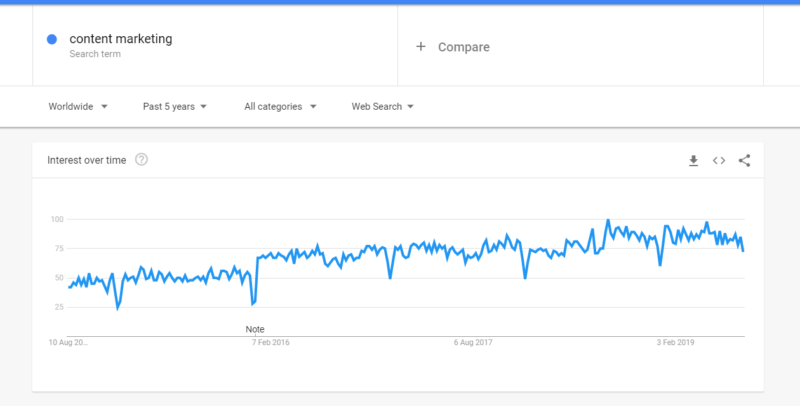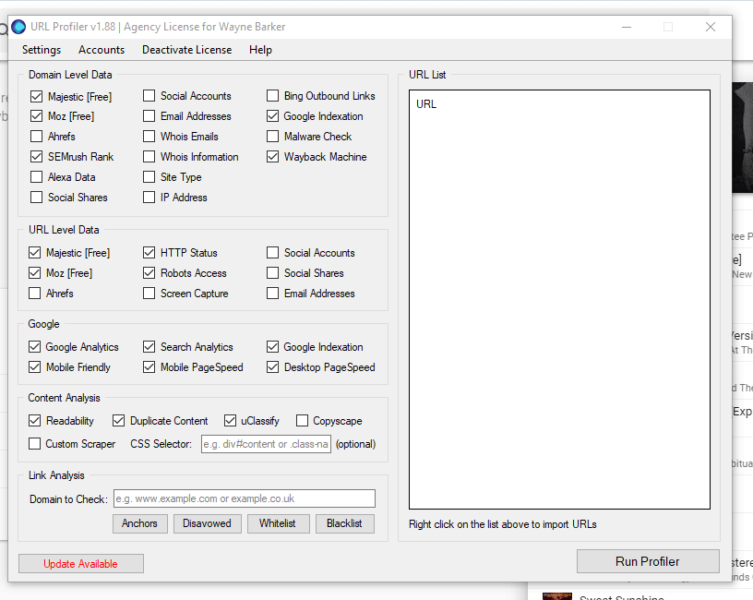
You only need to glance at the data in Google Trends to see how much interest in content marketing has increased in the last five years.

But while interest has spiked, uptake has been relatively slow. The problem that comes with emerging tactics and trends is that it takes a while for digital marketers to use them effectively. In a study by Marketing Profs and CMI into content marketing strategy, it was discovered that 75% of marketers are using content marketing at their organization.
The most surprising finding from that study was that 63% of organizations don’t have a documented content strategy. That poses a problem if the strategy isn’t documented and analyzed. How can we measure its ROI? How do we know the tactics we’re using are the right ones?

This lack of documentation worries me. It can lead to:
- The creation of multiple pieces of content around the same subject
- Multiple landing pages created by different teams
- Issues with keyword cannibalization
That’s why I like to conduct a content audit for our clients early on in a campaign.
What is a content audit?
A content audit is an essential strategy for content marketers and can improve the quality of your site for both users and search engines.
However, many content marketers shy away from audits because of the amount of work involved.
At its simplest, a content audit is a process that involves a deep data dive into every single piece of content on your site.
Yes. Every single piece.
Each and every content audit will differ somewhat in its intent and outcomes, but the overarching goal remains the same. You’re trying to understand how users and search engines perceive your content.
When you bring these two things together, you have, in my opinion, one of the most powerful strategies in digital marketing – the full content audit.
What should a content audit achieve?
I look at three core areas when performing a content audit.
Finding ways to repurpose content
Can your content be turned into a SlideShare or an infographic? There are many ways to take old content and turn it into something new. I particularly like to flag content that’s performed well organically and analyze how it can be used to create less expensive content with a known track record.
Finding content gaps
No site is ever finished, and your keyword research is never complete. When performing a content audit, I’m looking for content that competitors have on their websites (and rank for) that my clients don’t have on their sites.
There’s always more content that you can add to your site (and usually some that can be removed, too).
Optimize your content for users and search engines
Google has said it for many years; in fact, Matt Cutts went on record many times to tell webmasters that they needed to “create great content.”
This still stands true today.
Conducting a content audit can help you identify areas of your site that are in need of improvement, and that will see greater visibility in search as a result.
What are the SEO benefits of a content audit?
There are many ways a content audit can help improve the organic performance of your site. Some of the most immediate ones are:
- Improving rankings
- Improving conversion rates
- Removal of duplicate pages
- Fixing keyword cannibalization
What sort of data do you need for a content audit?
This differs from site to site. The data for a million-page e-commerce site is going to be a bit different to an audit for a 100-page site.
I have found the following data points to be an excellent place to start.
- Link data – this can come from any of your favorite SEO tools, although I highly recommend looking at more than one data set.
- Google indexation – is Google indexing your pages? If Google can’t get to them or there are errors, then you need to know about them.
- HTTP status – much like in a technical SEO audit I like to look at the HTTP codes. There are often some quick wins that can be uncovered.
- Page speed scores – how fast are your pages? Are there particular segments of pages that seem to load slower than others?
- Social shares – is your content being shared on social media?
- Content quality – is your content easy to read and understand? Are there any pages where sentiment analysis is negative?
- SEMrush (or similar) data – how are you performing organically based on the data of third party tools?
- Google Analytics data – how are users interacting with your pages? Why do some pages receive more organic traffic than others?
- Google Search Console data – what does Google say about your pages? Are there any that just aren’t getting any impressions?
- Duplicate content issues – do you have similar, competing pages that may not be performing as well as they could in the search results?
- Mobile-friendliness – are all of your pages mobile-friendly?
Other data points you might want to gather include screenshots of all pages on your site, historical URL data from the Wayback Machine, and whether the pages get a pass on Copyscape.
I have found that the 11 data points mentioned above are what you need to use for most content audits.
Using URL Profiler to gather the data
The volume of data needed for a content audit can be daunting. Gathering the data by hand could take weeks – if not longer.
That’s where URL Profiler comes in.
I’ve been using URL Profiler for my content audits for some time now, and there’s nothing else that comes close to the quality of data it delivers.
While the tool is a paid one, it is very affordable. They also offer a free 14-day trial so you can see if it’s a fit for you.
URL Profiler is desktop-based and has many data points to choose from.

This is how I usually set up URL Profiler for a content audit.

Domain-level data
- Majestic – you get 500 free lookups with an account
- Moz – again you get 500 free calls
- SEMrush Rank – API key required
- Google Indexation – I recommend you get some proxies before trying to check which pages are indexed by Google in such big numbers
- Wayback Machine – in case we can catch any old pages on which content has disappeared.
URL level data
- Majestic – you get 500 free lookups with an account
- Moz – again you get 500 free calls
- HTTP Status
- Robots Access
You can connect URL profiler to several Google products which can help in a content audit.
- Google Analytics – how many organic visits is each page of your site getting?
- Google Search Console – this will help you spot gaps between pages that get high numbers of impressions, yet no clicks.
- Mobile Friendliness
- Mobile and Desktop Pages Speeds – this is on a URL by URL basis
All these data points are going to bring back an excel sheet that looks like this.

From here, you can turn the CSV into a workbook and start applying conditional formatting before beginning to dive into the data.
Making decisions from your data
Some of the questions I like to ask myself when evaluating this data are:
- Do I have low-quality pages that can be removed?
- Do I have any pages that cannibalize other pages that could be merged?
- Are my external and internal links pointing to the right pages on my site?
- Can I add internal links from my strongest pages to improve the performance of weaker pages?
- Are there pages that would benefit from technical SEO fixes?
- Are there pages that Google doesn’t appear to be showing in search, and if so, how can I fix them?
- Are there any noticeable patterns that arise from my most popular content? Can I recreate that pattern on other pages?
- Do I have pages where I need to improve the quality of my content?
- Are the right pages ranking for the right keywords?
Be brave
Deleting content that you or your team have created can be difficult, but it’s often necessary.
Be brave. If it feels like content should be deleted, then delete it. If you think a page is cannibalizing another, then either delete one, or merge them.
Now is not the time to hesitate.
Fortune favors the bold.
[“source=searchengineland”]

